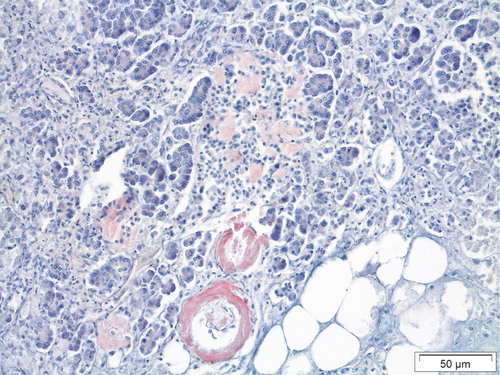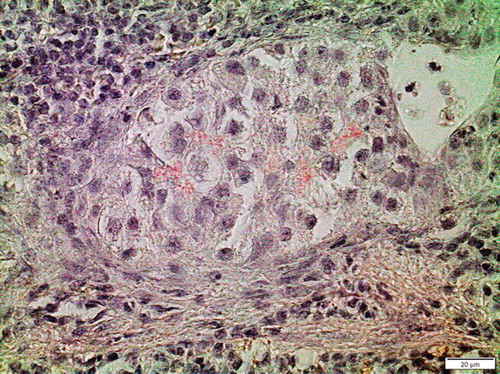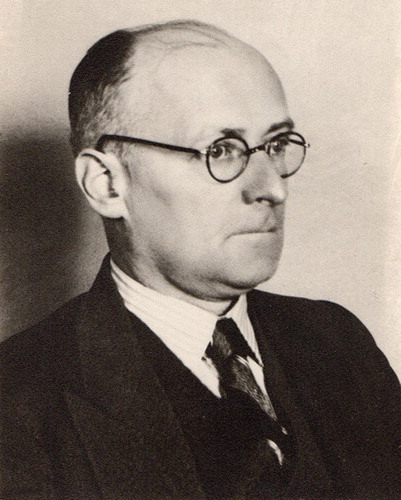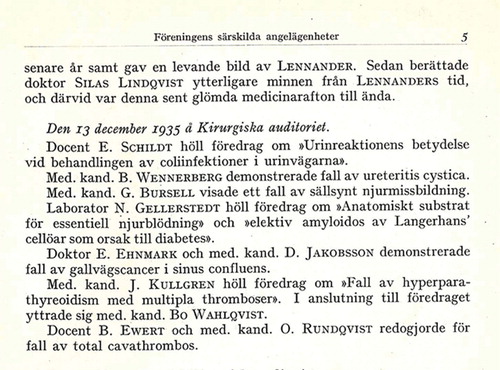Introduction
Science is said to be free in Sweden in the sense that scientists are allowed to do research on any subject, but there is one very serious limitation: the work has to be funded. The latter aspect has become increasingly evident during later years. In many ways, research was more free decades ago when more money was directly allocated to universities and their departments. In this way, islands of research could more easily develop around a successful scientist, and if he (it used to be men, at least in medical research) was lucky he might recruit a number of pupils who could take the research further. The most well-known example of this scenario in Uppsala of course is Carl von Linné (1707–1778) with his large group of famous disciples. On the other hand, it is a risk that a scientific line fades out rapidly when a leading and charismatic person dies or moves. There is a multitude of examples of this phenomenon.
The first demonstration of islet amyloid in Uppsala
During last decades amyloidosis has become a hot subject in medical research. Quite evidently, the number of scientists working on different aspects of amyloid has increased, also in Uppsala. But how was the situation earlier at Uppsala University? The first scientist interested in amyloid seems to have been a professor of pathology, Nils Gellerstedt (). Gellerstedt was known as an excellent clinical pathologist and seems to have had quite wide interests in a number of different conditions. He and some of his pupils published several papers on age-related (‘senile’) amyloid forms. Most interesting is perhaps an article published in 1938 dealing with amyloid in the islets of Langerhans (Citation1). That article by Gellerstedt was initiated by his observation of the presence of islet amyloid in two patients with diabetes mellitus. The scientific activity in Upsala Medical Society (Upsala Läkareförening) must have been very high at that time with many oral presentations each month. In the record of a meeting on 13 December 1935 it appears that Gellerstedt gave a talk entitled ‘Elective amyloidosis of islet of Langerhans as a cause of diabetes’ (). Unfortunately there is no written report from that meeting, but Gellerstedt refers to these two cases as a background to his following, extended study. According to the title of his presentation in Uppsala Gellerstedt regarded the found islet amyloid as the cause of diabetes in these two patients. In his more elaborated investigation from 1938 he studied sections from the pancreatic tail in 181 consecutive autopsies among which 110 were from subjects aged 50 years or more. Gellerstedt most certainly was disappointed by the new findings of his larger study. As expected, he found islet amyloid in subjects with diabetes but perhaps more surprisingly he found the alteration to be quite common among non-diabetic individuals as well, some of them with quite pronounced depositions. Gellerstedt finally concluded that it was not possible to see a direct causal relationship between islet amyloid and diabetes. This view has since then been the predominating one in the field of diabetes research until the last 10 years or so.
Remarks by Gellerstedt on the histological appearance of islet amyloid
For a very long time there was a discussion on whether hyaline in the islets of Langerhans was to be regarded as amyloid or not. Amyloid was at that time only defined by its appearance in the light microscope, i.e. a hyaline substance with some tinctorial properties, particularly metachromasy with certain aniline dyes and affinity for Congo red. The latter is still very much used in research and clinical practice although our present definition of amyloid is more sophisticated and based on protein molecular arrangements. Gellerstedt entered that discussion and proposed that islet hyaline actually should be regarded as amyloid as judged from his experience with staining with methyl violet and Congo red, beautifully illustrated by hand-coloured pictures in his article. However, he must have felt some uncertainty, since he put in a ‘para’ in the title and gave the hyaline deposits the designation (para)amyloid. The amyloid nature discussion was not finished with this paper but principally went on (Citation2,3) for decades until amyloid in general was defined by its cross-β-sheet fibrillar structure (Citation4-6), shown to be valid also for the islet form.
The study by Gellerstedt contains several other interesting points. He noted that the islet amyloid shows ‘classical colour reactions’ and that the metachromasy with methyl violet is very clear but the colour slightly different from general amyloid (‘allgemeine Amyloid’, most probably AA amyloidosis), also shown in his illustration (). This observation shows that with an open mind it is possible to find interesting facts without very sophisticated methods. Interestingly, the same colour difference can be seen with Congo red as we use this stain today (). It is now understood that amyloid is not a single substance but a conformational state that at least 30 human proteins can obtain in vivo, resulting in deposition of protein fibrils (Citation7). Although these fibrils look similar by means of electron microscopy and have the same general protein conformation and some properties in common, it is clear that there are differences (Citation8). However, Gellerstedt did not speculate much about the nature of the amyloid material although he mentioned the possibility of an antigen–antibody reaction. This was a common theory concerning the nature of amyloid in general at that time. The article ends with the prophetic statement that ‘The problem “senile amyloidosis” contains many interesting questions, studies of which may open new ways in research’ (). This was certainly true as we will see in the following.
Figure 3. Figure form Gellerstedt’s paper from 1938 showing islet amyloid in a patient with systemic amyloidosis. Although we do not know what type of systemic amyloidosis it is, AA amyloidosis was by far the most common form in Sweden at that time. Note the colour differences between the amyloids. The depicted section was stained with methyl violet.

Figure 4. A modern pancreatic section from a patient with AA amyloidosis due to rheumatoid arthritis and with islet amyloidosis of IAPP nature. A similar colour difference as in Figure 3 is seen in the two amyloid forms. Congo red.

Figure 5. Gellerstedt’s prophetic statements on p. 11 of his paper (1). In translation: ‘The problem “senile amyloidosis” contains many interesting questions, studies of which perhaps may open new ways in research. The most important is again serology. It is important to put more efforts than earlier into studies of the serological changes in the senium as well as immunobiological and allergic reactions in the healthy as well as sick organism, also in animal experiments. The studies must also widen into the psychiatric field; there are interesting problems regarding the development of senile and presenile psychoses due to antigen–antibody reactions and so on. — However, the pathological-anatomical research is not to be disregarded. The author tends to believe that a systematic and careful study of the different body tissues for presence of atypical amyloid deposits in old humans, perhaps also in animals, could discover additional, non-rare findings of similar nature’.

Reappearance of islet amyloid research in Uppsala
Gellerstedt published some additional articles on senile amyloidosis but nothing more about islet amyloid. After his decease in 1954 Gellerstedt’s knowledge capital on amyloid seems to have faded, and when one of us (P.W.) started his career in pathology in the late 1960s no one at the department knew anything about amyloid or even knew that someone had been interested in that subject. It was instead quite by accident that studies on islet amyloid started from a project on mast cells in diabetes (Citation9). In an early quantitative study published in Upsala Journal of Medical Sciences it was shown that islet amyloid is initiated in a few islets but as the degree of amyloid infiltration augments the number of affected islets increases as well (Citation10), as confirmed in a later study (Citation11). Another important finding, obtained by serial sectioning, was that deposits usually are spread throughout islets, particularly along capillaries, even in cases with comparably little amyloid (Citation10). These novel and quite intriguing findings fit very well with the present conception of formation of amyloid as a nucleation-dependent process (Citation12) and that amyloid actually can spread between islets in this way (Citation13).
IAPP and the precipitation of islet amyloid
Gellerstedt, like most other researchers at that time, thought that amyloid hardly could be a cause of diabetes since it occurs in non-diabetic subjects as well and there are always a number of unaffected or less affected islets left in diabetic patients (Citation1). At that time the nature of amyloid was only a matter of speculation, and its origin from blood vessels or fibroblasts was much discussed. Later electron microscopic studies showed a close relationship between islet amyloid and β-cells (Citation14). This finding was important in two respects. First, it indicated that islet amyloid is a product of β-cells. Second, it showed that even if deposits were slight, they were widely spread within the islet and resulting in virtual holes in β-cell membranes, something that should result in functional loss. However, not much happened on islet amyloid until its composition of a previously unknown regulatory peptide was untangled (Citation15). This peptide, named islet amyloid polypeptide (IAPP, or amylin) was shown to be a 37-amino-acid residue peptide, most closely related to calcitonin-gene related peptide (CGRP). It was demonstrated to be expressed by β-cells where it is stored and released together with insulin (reviewed in (Citation16)). Initially, IAPP was believed to cause insulin resistance in type 2 diabetes, but when it turned out that a superphysiological plasma concentration is needed to initiate such an effect the interest in function of IAPP declined somewhat.
However, the interest in IAPP has increased considerably again, but now as an amyloid-forming peptide rather than for its effects via receptors. Deposition of IAPP amyloid is associated with a decline in the number of β-cells in human beings (Citation17,18), even in the absence of diabetes (Citation17). Presence of islet amyloid is associated with β-cell apoptosis, and no apoptotic cells are detected in non-amyloid containing islets (Citation11). Why islet amyloid cytotoxicity is limited to β-cells and α-cells are spared (Citation19) may suggest differences in cell surface-associated molecules. The mechanism is unclear, however. Like the situation with Alzheimer’s disease and the Aβ peptide, the interest has moved from the mature amyloid fibrils to pre-fibrillar aggregation states, often named oligomers or protofibrils. Such aggregates of misfolded peptides, including Aβ and IAPP, have been shown to exert toxic effects on cells in many systems in vitro. Therefore, there is strong evidence that a major cause of the reduction of and impaired function of β-cells in type 2 diabetes is aggregation of IAPP in the islets of Langerhans.
Amyloidosis in transplanted islets
Studies based on transplantation of pancreatic endocrine tissue into nude mice—diabetic or non-diabetic—were performed in one of our laboratories in the 1970s. Thus, for instance isolated human islets were injected intraperitoneally (Citation20), and porcine islet-like cell clusters (Citation21) or human fetal pancreas (Citation22) were grafted under the renal capsule. When isolated human islets became more regularly available, thanks to the collaboration with the laboratory in Brussels, we carried out extensive studies on the long-term in vivo effects of high glucose concentrations (Citation23) and alloxan (Citation24) on human islet tissue. It was then logical to look for the possible development of amyloid deposits in the same type of grafted tissue. To some surprise such deposits were demonstrated even in islet grafts from young, non-diabetic donors (Citation25). These first studies were carried out on renal, subcapsular islet grafts, but extended studies revealed that islet amyloid developed in intrasplenic () and liver grafts as well (Citation26). We were also able to demonstrate the deposition of amyloid in transplanted islets prepared from transgenic mice expressing human IAPP (Citation27).
Figure 6. Human islet from a non-diabetic subject transplanted into the spleen of a nude mouse. Pronounced amyloid deposits had developed within the islet after 1 month. Congo red.

Against this strong evidence of an exaggerated development of amyloid in transplanted human islets it was with tense expectations that we undertook the first investigations of liver sections from a deceased diabetic patient grafted intraportally with isolated islets about 5 years prior to his death (Citation28). Quite a few islets were identified, and interestingly enough many of them (40%) contained IAPP amyloid deposits as assessed by means of Congo red staining and immunolabelling with specific antibodies. In a follow-up study there was further evidence for amyloid deposition in clinical pancreatic islet grafts in that one patient from Edmonton and one patient from Milan also had such deposits in their islet grafts (Citation29). Since there is a decline in function in such islets (Citation30) it is tempting to believe that islet amyloid formation is an important cause (Citation16,29,31).
Our findings of amyloid in human islets, both grafted and cultured specimens, have been repeatedly reproduced. Perhaps the most informative one of these reports is that of Potter et al. (Citation32) demonstrating that while human islet grafts suffer from the deposition of amyloid after transplantation into nude mice, porcine islets do not. The explanation for this is that porcine IAPP lacks the ability to form amyloid due to its amino-acid sequence. Therefore porcine islets might be useful for clinical islet transplantation.
Islet amyloidosis and Alzheimer’s disease—is there a link?
In this context it may be relevant with a reflection. Alzheimer’s disease is an age-related condition which is associated with deposition of amyloid as plaques in the cerebral cortex and in cerebral blood vessels. These pathological traits have been known for a long time, but the importance of the alterations has not been well understood. Alzheimer research was for a long time very much focused on disturbances in cerebral transmitters, and not much happened in the field. Thus, when Glenner (Citation33,34) and Beyreuther and Masters (Citation35) discovered the Aβ peptide it meant a sudden, unexpected, and completely new direction in Alzheimer research. This field completely exploded and almost everyone moved to Aβ research. Why did the same not happen with islet amyloid and IAPP? One may suspect that researchers in the diabetes field have had difficulties to liberate themselves from old ideas and to accept new ones, and this is probably true generally in science. Another likely possibility is that for a long time type 2 diabetes was regarded as a disease dependent on peripheral insulin insensitivity with no direct β-cell lesion other than that these cells ‘burnt out’ due to constant stress exerted by high plasma glucose concentrations. In a way this may not be completely wrong since hyperglycemia is believed to drive IAPP overexpression, impaired processing of proIAPP, and dissociation from parallel expression with insulin (reviewed in (Citation16)). However, slowly, IAPP amyloid or pre-amyloid assemblies are increasingly accepted as important players in the pathogenesis of type 2 diabetes.
Interestingly, several epidemiological studies support a link between type 2 diabetes and Alzheimer’s disease, two conditions that have local amyloid formation in common as a component in their respective pathogenesis. Comparison of Aβ and IAPP amino-acid sequences point to a 50% identity which is slightly higher in regions identified as important for amyloid formation (Citation36). In in vitro studies on amyloid seeding, IAPP and Aβ can cross-seed (Citation36) and injections of preformed Aβ-fibrils to human IAPP transgenic mice trigger islet amyloid formation (Citation13). Further studies on brain tissue from patients with Alzheimer’s disease with the antibody-based proximity ligation assay revealed co-localization of IAPP and Aβ in both diffuse and dense plaques and in amyloid deposits present in cerebral vessel walls. Therefore, it is possible that cross-seeding could be a mechanism that links the two diseases.
Our increasing understanding of the importance of IAPP aggregation in the pathogenesis of type 2 diabetes as well as the development in the Alzheimer field underlines that Gellerstedt was right when he in 1938 wrote ‘The problem “senile amyloidosis” contains many interesting questions, studies of which perhaps may open new ways in research’ (Citation1).
Acknowledgement
The authors thank Nils Gellerstedt, Kungsbacka, for providing a photo of his father.
Declaration of interest: The authors report no conflicts of interest. The authors alone are responsible for the content and writing of the paper.
References
- Gellerstedt N. Die elektive, insuläre (Para-)Amyloidose der Bauchspeicheldrüse. Zugleich ein Beitrag zur Kenntnis der “senilen Amyloidose”. Beitr Path Anat. 1938;101:1–13.
- Ehrlich JC, Ratner IM. Amyloidosis of the islets of Langerhans. A restudy of islet hyalin in diabetic and nondiabetic individuals. Am J Path. 1961;38:49–59.
- Warren S, LeCompte PM, Legg MA. The pathology of diabetes mellitus. 4th ed. Philadelphia: Lea & Febiger; 1966.
- Cohen AS, Calkins E. Electron microscopic observations on a fibrous component in amyloid of diverse origins. Nature. 1959;183:1202–3.
- Eanes ED, Glenner GG. X-ray diffraction studies on amyloid filaments. J Histochem Cytochem. 1968;16:673–7.
- Glenner GG, Eanes ED, Bladen HA, Linke RP, Termine JD. β-pleated sheet fibrils. A comparison of native amyloid with synthetic protein fibrils. J Histochem Cytochem. 1974;22:1141–58.
- Sipe JD, Benson MD, Ikeda S, Merlini G, Saraiva MJ, Westermark P. Updated nomenclature 2014: amyloid fibril proteins and clinical classification of the amyloidoses. Amyloid. 2014;21:221–4.
- Eisenberg D, Jucker M. The amyloid state of protein in human diseases. Cell. 2012;148:1188–203.
- Westermark P. Mast cells in the islets of Langerhans in insular amyloidosis. Virchows Arch Path Anat. 1971;354:17–23.
- Westermark P. Quantitative studies of amyloid in the islets of Langerhans. Upsala J Med Sci. 1972;77:91–4.
- Jurgens CA, Toukatly MN, Fligner CL, Udayasankar J, Subramanian SL, Zraika S, et al. β-cell loss and β-cell apoptosis in human type 2 diabetes are related to islet amyloid deposition. Am J Pathol. 2011;178:2632–40.
- Rochet J-C, Lansbury PTJ. Amyloid fibrillogenesis: themes and variations. Curr Opin Struct Biol. 2000;10:60–8.
- Oskarsson ME, Paulsson JF, Schultz SW, Ingelsson M, Westermark P, Westermark GT. In vivo seeding and cross-seeding of localized amyloidosis: a molecular link between type 2 diabetes and Alzheimer’s disease. Am J Pathol. 2015;185:834–46.
- Westermark P. Fine structure of islets of Langerhans in insular amyloidosis. Virchows Arch A Pathol Pathol Anat. 1973;359:1–18.
- Westermark P, Wernstedt C, Wilander E, Sletten K. A novel peptide in the calcitonin gene related peptide family as an amyloid fibril protein in the endocrine pancreas. Biochem Biophys Res Commun. 1986;140:827–31.
- Westermark P, Andersson A, Westermark GT. Islet amyloid polypeptide, islet amyloid and diabetes mellitus. Physiol Rev. 2011;91:795–826.
- Westermark P, Grimelius L. The pancreatic islet cells in insular amyloidosis in human diabetic and non-diabetic adults. Acta Path Microbiol Scand A. 1973;81:291–300.
- Clark A, Wells CA, Buley ID, Cruickshank JK, Vanhegan RI, Matthews DR, et al. Islet amyloid, increased A-cells, reduced B-cells and exocrine fibrosis: quantitative changes in the pancreas in type 2 diabetes. Diabetes Res. 1988;9:151–9.
- Law E, Lu S, Kieffer TJ, Warnock GL, Ao Z, Woo M, et al. Differences between amyloid toxicity in alpha and beta cells in human and mouse islets and the role of caspase-3. Diabetologia. 2010;53:1415–27.
- Lundgren G, Andersson A, Borg H, Buschard K, Groth CG, Gunnarsson R, et al. Structural and functional integrity of isolated human islets of langerhans maintained in tissue culture for 1-3 weeks. Transplant Proc. 1977;9:237–40.
- Korsgren O, Jansson L, Eizirik D, Andersson A. Functional and morphological differentiation of fetal porcine islet-like cell clusters after transplantation into nude mice. Diabetologia. 1991;34:379–86.
- Sandler S, Andersson A, Schnell A, Mellgren A, Tollemar J, Borg H, et al. Tissue culture of human fetal pancreas. Development and function of B-cells in vitro and transplantation of explants to nude mice. Diabetes. 1985;34:1113–19.
- Jansson L, Eizirik DL, Pipeleers DG, Borg LA, Hellerström C, Andersson A. Impairment of glucose-induced insulin secretion in human pancreatic islets transplanted into diabetic nude mice. J Clin Invest. 1995;96:721–6.
- Eizirik DL, Pipeleers DG, Ling Z, Welsh N, Hellerström C, Andersson A. Major species differences between humans and rodents in the susceptibility to pancreatic beta-cell injury. Proc Natl Acad Sci USA. 1994;91:9253–6.
- Westermark P, Eizirik DL, Pipeleers DG, Hellerström C, Andersson A. Rapid deposition of amyloid in human islets transplanted into nude mice. Diabetologia. 1995;38:543–9.
- Westermark GT, Westermark P, Nordin A, Törnelius E, Andersson A. Formation of amyloid in human pancreatic islets transplanted to the liver and spleen of nude mice. Ups J Med Sci. 2003;108:193–204.
- Westermark GT, Westermark P, Eizirik D, Hellerström C, Fox N, Steiner DF, et al. Differences in amyloid deposition in islets of transgenic mice expressing human islet amyloid polypeptide versus human islets implanted into nude mice. Metabolism. 1999;48:448–54.
- Westermark GT, Westermark P, Berne C, Korsgren O. Widespread amyloid deposition in transplanted human pancreatic islets. N Engl J Med. 2008;359:977–9.
- Westermark GT, Davalli AM, Secchi A, Folli F, Kin T, Toso C, et al. Further evidence for amyloid deposition in clinical pancreatic islet grafts. Transplantation. 2012;93:219–23.
- Ryan EA, Paty BW, Senior PA, Bigam D, Alfadhli E, Kneteman NM, et al. Five-year follow up after clinical islet transplantation. Diabetes. 2005;54:2060–9.
- Westermark P, Andersson A, Westermark GT. Is aggregated IAPP a cause of beta-cell failure in transplanted human pancreatic islets? Curr Diab Rep. 2005;5:184–8.
- Potter KJ, Abedini A, Marek P, Klimek AM, Butterworth S, Driscoll M, et al. Islet amyloid deposition limits the viability of human islet grafts but not porcine islet grafts. Proc Natl Acad Sci USA. 2010;107:4305–10.
- Glenner GG, Wong CW. Alzheimer’s disease: initial report of the purification and characterization of a novel cerebrovascular amyloid protein. Biochem Biophys Res Commun. 1984;120:885–90.
- Glenner GG, Wong CW. Alzheimer’s disease and Down’s syndrome: sharing of a unique cerebrovascular amyloid fibril protein. Biochem Biophys Res Commun. 1984;122:1131–5.
- Masters C, Simms G, Weinman NA, Multhaup G, McDonald BL, Beyreuther K. Amyloid plaque core protein in Alzheimer disease and Down syndrome. Proc Natl Acad Sci USA. 1985;82:4245–9.
- O’Nuallian B, Williams AD, Westermark P, Wetzel R. Seeding specificity in amyloid growth induced by heterologous fibrils. J Biol Chem. 2004;279:17490–9.



